A Culture of Service: Part Three
by Jon Fukuda
This post is the final installment in our 2022 “Culture of service series”. This post will cover our second community service project we volunteered for as a way to dig into our value of stewardship.
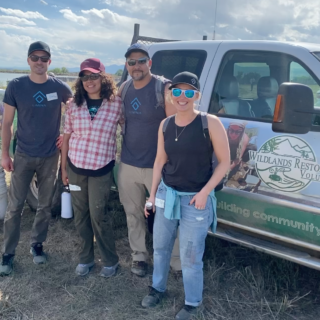
McIntosh Lake Wetland Restoration
Longmont, CO
On Saturday, Sept 17, 2022, as a part of our continued community service, we joined up with Longmont’s POST (Parks, Outdoors, Streams, and Trails) Volunteer department and the Wildlands Restoration Volunteers (WRV) teams along with other volunteers to continue implementing phase 3 of the McIntosh Lake Masterplan. Phase 3 objectives are to support riparian ecosystem restoration of the west bank of the lake with tree and shrub plantings. This restoration work is made possible by the Great Outdoors Colorado (GOCO) cooperative volunteer grant program. All told there were roughly 25-30 volunteers.
Project Outline, provided by Taylor Gifford, City of Longmont Natural Resource Volunteer Coordinator
The goal of this project work is to create a more diverse habitat along the northern shore of McIntosh Lake for nesting and migrating birds. In this area, concentrated prairie dog activity has stripped the shore of all native vegetation, leaving compacted dirt and weeds. Our primary goal on this project – and many others – is increasing biodiversity. By planting and caging a diverse variety of native perennial shrubs, we hope to restore the natural plant diversity of the area. This will, in turn, restore animal diversity, and soil diversity. After several years of protecting and watering these shrubs, we should have a variety of established shrubs and small trees along this section of shore – ensuring shelter and food availability for a greater variety of wildlife. By planting a number of fruiting shrub species, wildlife will assist in spreading some of these native species throughout the McIntosh Lake area by consuming and dispersing the seeds and berries produced.
A secondary goal of this project is to improve soil structure and quality. The plants we put in the ground will grow extensive root systems and create organic material which improves both soil stability and soil quality. These soil improvements should reduce run-off of contaminants and sediment which will improve water quality within the lake itself. The improved soil quality will increase ground absorption, creating more opportunities for plant-life, while additionally providing the benefit of improved resilience to flooding in the surrounding areas.
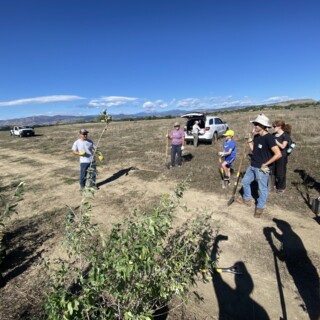
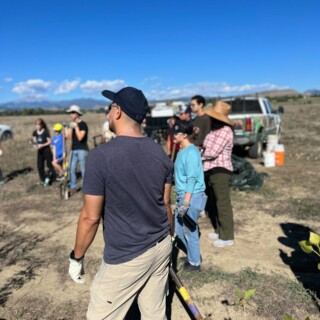
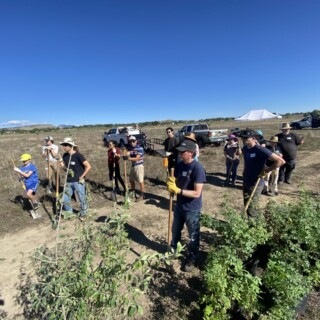
Orientation
Our day started at 9 am with a check-in, name tagging, and an ice-breaker for the volunteers to get to know one another. As part of our volunteer orientation, the coordinators went over the objectives for the project along with best practices in tool use and safety, a walkthrough of roughly 15 varieties of native shrubs and trees, and a brief tutorial on planting and berming for optimal watering. There were roughly 350 plants total consisting of 11 perennial native species including Coyote willow, Plains cottonwood, Silver buffaloberry, Woods rose, Golden currant, False indigo, Rabbitbrush, Dogwood, Three-leafed sumac, Chokecherry, and Wild plum.
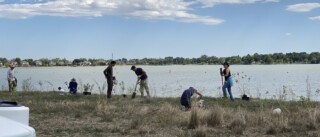
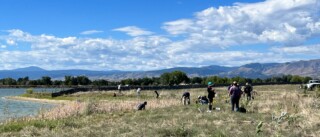
Getting to Work
After the orientation, we set to work on an approximately 930-foot stretch of the west bank of the lake in a band about 150 feet from the shoreline up to about 20 feet. We interspersed some of the faster-growing native cottonwoods, willows, and other riparian trees with a variety of native shrubs to eventually help establish both a canopy and understory.
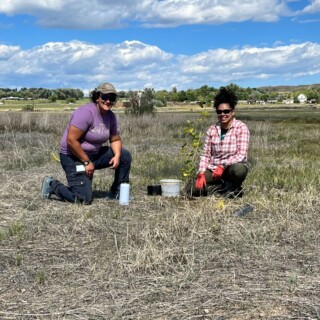
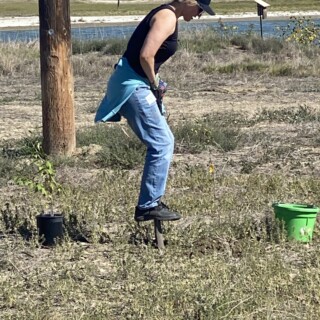
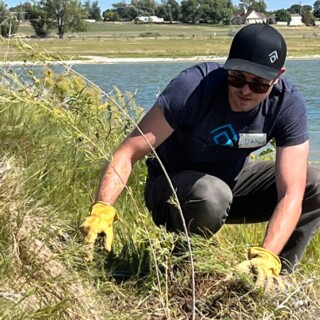
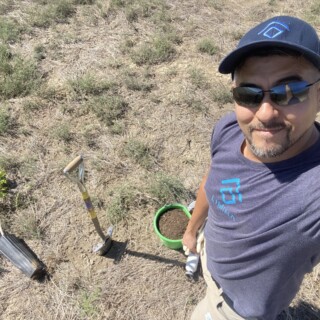
The volunteers worked straight through from 10 am to 12 pm planting, berming, and watering trees and shrubs in a scattered grid every 30-40 feet. After a lunch break, we wrapped up planting in about an hour and moved on to placing cages to protect the plants from a neighboring protected colony of prairie dogs.
These prairie dogs are a fixture on Lake McIntosh and as a protective instinct, will clear out any growth with a trunk diameter under 3 inches to provide them with a clear line-of-sight in case of any potential predators. Our plantings were young and would otherwise be leveled by the colony. We caged 75 plantings that were closest to the colony and most at risk. The other plantings we protected by a divider wall and a further distance away which should keep them from getting leveled.
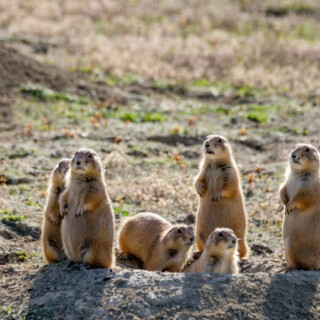
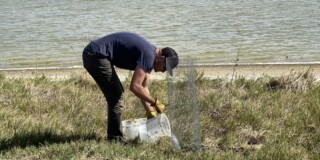

Key Lessons
In Part 2 of Our Culture of Service, we looked for lessons in trail restoration that we could take back to our own practice. For this project, I’ll use the restoration, conservation, and establishment resilient ecosystem as an analog to adding sustainable features, functions, or new components and workflows to a system. Both types of projects need:
-
Careful planning, coordination, support, resources, funding, and leadership
In this case, that role is played by Longmont POST, supported by partnerships with Wildlife Restoration Volunteers and volunteer residents with funding secured by GOCO
-
Providing accessible and efficient resources during implementation is critical.
Planning, design, and management is one part of good project management, but laying the groundwork and facilitating the implementation process have to match. In this case, the project managers provisioned the volunteers, plants, tools, buckets, and two well-placed 300-gallon water tanks. As well, they had subject matter experts on hand providing instruction, supervision, and answering any questions that came up throughout the implementation. To our team, this was analogous to making sure implementation teams have all the design plans, specifications, UI components, workflows, and user stories to support their build, but also making sure that subject matter experts are available to prevent assumptions and personal bias from running amok in the process.
-
Teamwork makes the dream work.
If someone told us in advance how many trees and shrubs, and how much territory we were supposed to cover from the outset, we would have been skeptical. The coordinators made sure we had a good size team of volunteers and broke us into area teams. By taking clusters of plants at a time, the work never felt overwhelming. As the primary task of planting and watering, started tapering off, part of the crew pealed off to build cages and set them around the bases of plants at risk. By keeping teams divided into smaller and staggered tasks we were able to cover a lot of ground and execute quickly and efficiently.
-
Small innovations that drive efficiency can help the whole team.
While we moved from digging plants to watering… the crew was walking back and forth to the water tank with buckets. This was fine, but each member could only carry two one-gallon buckets at a time. Our Sr. project manager, Dan Hartman, came up with the idea to load up 5 buckets on a shovel handle, and between two people carrying the pole, and a separate bucket in their free hand, they were able to move seven gallons per round trip as opposed to what would have been four. These small gains, including a couple of folks at the water tank loading empty buckets as they came in increased our productivity by at least 30%. In our projects, both internal and client-facing, we’re always looking for these opportunities to increase the efficiency, quality, and velocity of our productivity. On this day of service, we wrapped up two hours ahead of schedule!
-
Remember to celebrate your achievements
After wrapping up, the coordinators shared a number of statistics – 350 trees & shrubs planted, 700 plantings watered, and 75 cages build and placed coming in under our expected closing time. They gave thanks, and took group photos! Our team later met up to rest and relax over a home-cooked meal, and drinks! We all came away with a sense of satisfaction in contributing to wildlife restoration, and ecological sustainability as well as some lessons to serve us in our continued work. To look for opportunities to steward, work together, drive collective success, and celebrate our achievements!


Giving Thanks
We’re grateful for the opportunity to contribute to Longmont’s ecological resilience and specifically to Taylor Gifford, the City of Longmont’s Natural Resources Volunteer Coordinator. For more opportunities to volunteer check out their calendar of events.
Taylor was kind enough to share this note in an email to our team:
“I’d like to express a big, big THANK YOU to the Limina crew. It was great having your team’s help both at McIntosh and Button Rock this year! Your folks are awesome. They absolutely rocked it, and your work made a big difference. I hope to work with you all again next year!”